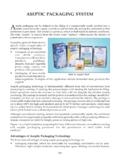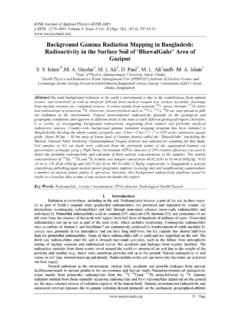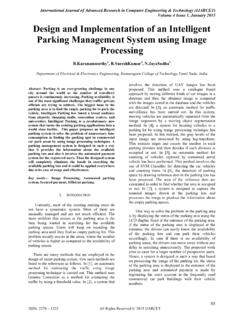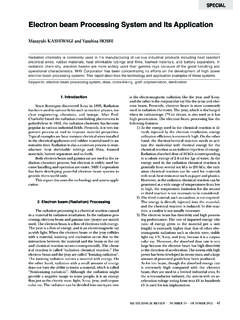Transcription of ISO 21348 Definitions of Solar Irradiance Spectral …
1 ISO 21348 information is provided courtesy of Space Environment 21348 Definitions of Solar Irradiance Spectral CategoriesSpectralcategorySpectralsub-ca tegoryWavelength range (nm)Wavelength range (SI pre-fixes from Table 2)NotesTotal SolarIrradiancefull-disk, 1 ua Solar Irradiance inte-grated across all < fm < 1 < pm < nmHard < nm < 10 nmSoft X-raysUV100 < 400100 nm < 400 nmUltravioletVUV10 < 20010 nm < 200 nmVacuum UltravioletEUV10 < 12110 nm < 121 nmExtreme UltravioletH Lyman- 121 < 122121 nm < 122 nmHydrogen Lyman-alphaFUV122 < 200122 nm < 200 nmFar UltravioletUVC100 < 280100 nm < 280 nmUltraviolet CMUV200 < 300200 nm < 300 nmMiddle UltravioletUVB280 < 315280 nm < 315 nmUltraviolet BNUV300 < 400300 nm < 400 nmNear UltravioletUltravioletUVA315 < 400315 nm < 400
2 NmUltraviolet AVIS380 < 760380 nm < 760 nmoptical360 < 450360 nm < 450 nmpurple450 < 500450 nm < 500 nmblue500 < 570500 nm < 570 nmgreen570 < 591570 nm < 591 nmyellow591 < 610591 nm < 610 nmorangeVisible610 < 760610 nm < 760 nmredIR760 < 1 000 000760 nm < mmIR-A760 < 1 400760 nm < mmNear InfraredIR-B1 400 < 3 mm < mmMiddle InfraredInfraredIR-C3 000 < 1 000 mm < mmFar infrared1 000 000 < 15 000 mm < 106 < mm < mm( > ) 106 < mm < mm( > ) 106 < mm < mm( > ) 106 < mm < mm( > ) 107 < mm < mm( > ) 107 < mm < mm( > ) 107 < mm < mm( > ) 108 < mm < mm( > ) 108 < mm < m( > ) GHz100 000 < 100 000 000 mm < 100 mmeasurements.
3 (1 000 000 < 10000 000 000) 106 < mm < mmExtremely High Frequency (300 > 30) 107 < mm < mmSuper-High Frequency (30 > 3) 108 < mm < mUltra-High Frequency (3000 > 300) 109 < m < mVery-High Frequency (300 > 30) 1010 < m < mHigh Frequency (30 > 3) MHzISO 21348 Process for Determining Solar Irradiances Compliance CriteriaRationaleThe compliance criteria for this standard consist of activities that are common to Solar Irradiance product types (section 5) and Solar irradiancespectral categories (section 6). These criteria specify a compliance process for the determination of Solar irradiances that includes the reporting,documenting, publishing, and archiving of Solar Irradiance 21348 information is provided courtesy of Space Environment irradiances shall be reported in SI units, W m-2 and Solar Spectral irradiances shall be reported in SI units, W m-3.
4 The conversion to other ap-propriate conventional units such as W m-2 nm-1 can be additionally applied. The reported irradiances shall be described as to whether or not theyare corrected to 1 ua. It is recommended, though not required, that reported irradiances are corrected to 1 ua. If applicable, the wavelength bins( Spectral sampling) and Spectral resolution (bandpass) shall be reported for Solar Irradiance method of determining Solar irradiances shall be documented and, as appropriate, shall include data collection, retrieval, processing, calibra-tion, validation, verification, accuracy, and precision methodology and/or algorithms, as well as archiving For measurements, including spacecraft observations, rocket experiment data sets, and ground-based observations (includingballoons)
5 , a description of the responsible agent or institution and the instrumentation used to collect and retrieve the irradiances shall be data processing algorithms, the instrument calibration techniques and heritage, the method of determining accuracy and precision, the valida-tion and verification methodology, as well as the archival processes shall be spectra. For reference spectra, including the mean of spectra over several Solar cycles or spectra for a variety of Solar activity condi-tions, the rationale for specifying a spectrum as a reference shall be described. The measurement set(s) used to derive the reference spectrum, themethod of resolving discrepancies between multiple data sets, the data processing algorithms, the method of determining accuracy and precision,the validation and verification methodology, as well as the archival processes shall be models.
6 For empirical models, including those based on one or many space- or ground-based measurement sets, or for hybrid models, adescription of the rationale for developing the model, its areas of application, and the rationale for selecting proxies shall be described. The meas-urement data sets used in the derivation, the mathematical formulation of the model, the method of resolving discrepancies between multiple datasets, the derivation algorithms, the method of determining accuracy and precision, the validation and verification methodology, as well as the ar-chival processes shall be models. For theoretical or first-principles models of Solar processes, a description of the physical principles that are used as the basisof the model, the rationale for developing the model, and its areas of application shall be described.
7 The numerical algorithms that produce Solar ir-radiances, the mathematical formulation of the model, the method of determining accuracy and precision, the validation and verification method-ology, as well as the archival processes shall be Irradiance proxies. For Solar Irradiance proxies, a description of the rationale for developing the proxy and its areas of application shall bedescribed. Where appropriate, the data sets used in the derivation, the mathematical formulation of the proxy, the method of resolving discrepan-cies between multiple data sets, the derivation algorithms, the method of determining accuracy and precision, the validation and verification meth-odology, as well as the archival processes shall be documented Solar Irradiance product shall be published in an internationally-accessible journal which uses scientific or discipline-area peerreview in the publication process.
8 For any Irradiance product, the published article may point to a permanent electronic archival location where thearchived measurements, spectra, models, or proxies can be found, accessed, or recreated by an international documented and published Solar Irradiance product shall be archived in a method consistent with any contemporary technology that ensureslong-term international of compliance with this standard shall be achieved by complying with the criteria listed in section 7. Self-declaration of compliancein an archival publication as part of section can be accomplished by using the statement The process used for determining Solar irradiancesreported herein is compliant with ISO International Standard 21348 : Space Environment (Natural and Artificial) Process for determining Solar ir-radiances.
9 The type designation (section 5) and the Solar Irradiance Spectral category (section 6) shall be identified along with the self-declarationof Irradiance Spectral categories from gamma-rays through radio wavelengths.







